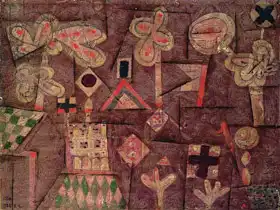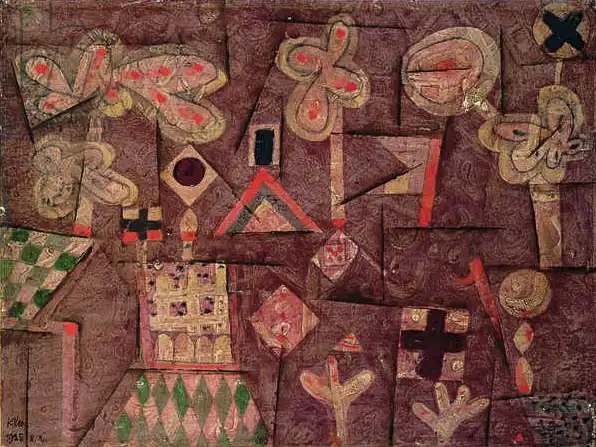About this finishing
Print. The image is printed on the top quality 10-ink HP Z9PS printer on HP matte 270 g / m2 paper. You can choose any size to an accuracy of 1 cm. A margin of 5 cm around the image is added to the size of the motif.


You can find a detailed description about our finishings
here.
Gingerbread Picture
Date:
1925Medium:
oil and pencilLocation:
Sammlung Berggruen, Berlín, NěmeckoDimensions:
21.6 x 28.6The painting is an abstract composition with various geometric and organic shapes, which are laid out on a dark brown or burgundy background. The colours of the shapes range from earth tones to subtle shades of pink and green. Some of the shapes may resemble trees or flowers, while others represent irregular lines and blocks. Overall, the artwork evokes a feeling of primitive art or children's drawings, with accents of naive style and innocence. The work may be inspired by folkloric motifs or a child's imagination.
This description was created by artificial intelligence, please be indulgent.
Klee painted picture Gingerbread Picture in 1925. Prevailing color of this fine art print is dark and its shape is landscape. Original size is 21.6 x 28.6. This art piece is located in Sammlung Berggruen, Berlín, Německo. This image is printed on demand - you can choose material, size and finishing.
Paul Klee (1879-1940). From childhood, he was interested in both music and painting, but as is evident, finally decided on painting - his paintings are among prized artworks. In Munich, he met
Kandinsky, Franz Marc, and other artists of the then avant-garde. He met also his future wife, pianist Lily Stumpf. His work is associated with a
expressionism, cubism, and
surrealism. He was one of the four Die Blaue Vier (with Kandinsky, Feininger and Jawlensky). He taught at Bauhaus and the Düsseldorf Academy until 1933, when the Nazis declared his paintings a figment of a sick soul and with labelled his whole creation as degenerate art. Klee was extremely hardworking and after his death, he left behind 8926 works in Switzerland. Klee’s paintings are fragile, with a sensitive use of color (his colour mixing ranks among the world’s best) and frequent references to poetry, music and dreams.


